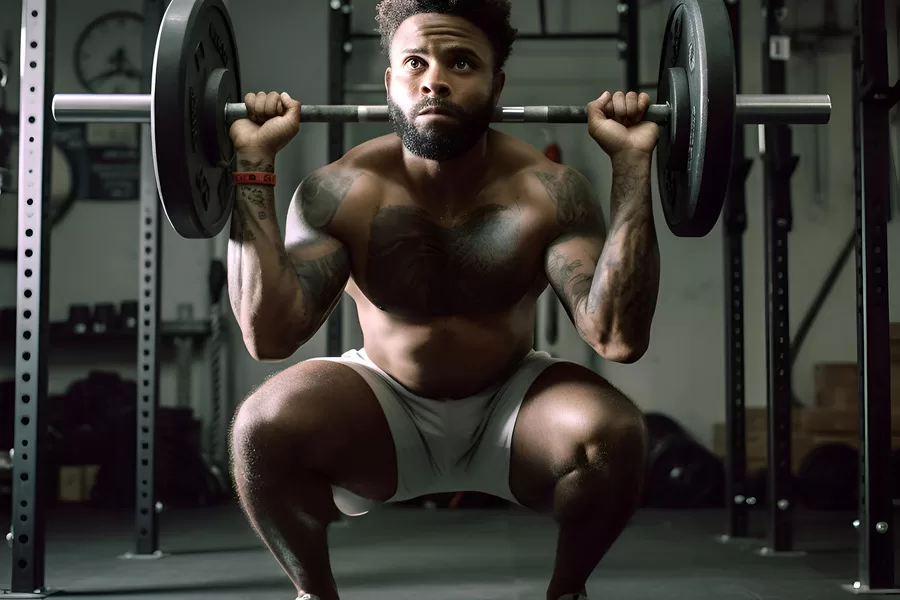
Do you want to change your body? Make it more athletic? How to start training correctly in order to avoid harmful consequences for your health? Here you will learn the basics for beginners who want to start workouts , so let’s get started.
Mass Building for Beginners
How Muscles Grow:
When you start exercising, especially with weights, your muscles begin to change. It’s like they’re learning to be stronger. Each time you lift weights, you’re giving your muscles a new challenge. After your workout, your body works on these muscles, making them stronger and a bit bigger. This change doesn’t happen overnight, but with regular exercise, you’ll start to notice your muscles growing.
Food for Muscle Building:
To help your muscles grow, you need to eat the right food. Protein is really important for your muscles. It’s like the main ingredient that helps fix and build your muscles. Foods like chicken, eggs, beans, and tofu are great for protein. Carbohydrates give you energy for your workouts. Foods like bread, rice, and potatoes are good sources. Healthy fats are also needed. They come from foods like avocados, olive oil, and nuts. Don’t forget to drink lots of water, too. It’s important for keeping your muscles healthy.
The Importance of Rest:
Rest is just as important as exercise and diet for building muscle. When you rest, your body repairs and builds your muscles. This mostly happens when you sleep. So, getting enough sleep and taking breaks from exercise are really important. Rest days are when your muscles get a chance to grow and get stronger.
Balance is Key:
Building muscle involves three main things: regular exercise, eating right, and getting enough rest. It’s like a puzzle where each piece is important. If one piece is missing, like not getting enough rest or not eating right, you won’t see the best muscle growth. Keeping these three things in balance is the secret to building strong muscles.
Workout Plan for Beginners
Starting:
You start at the beginning and get better as you practice. Begin with exercises that are a bit challenging but not too tough. It’s like taking small steps to reach a big goal. Start with lighter exercises and gradually make them harder. This helps your body get used to exercising and builds your strength steadily.
What is Progressive Overload?
It means slowly increasing how much you exercise. Imagine you’re learning to lift something heavy. You don’t start with the heaviest thing. You start small and add a little more weight over time. In working out, this means lifting a bit heavier weight or doing a few more exercises each time. It helps your muscles get stronger and grow.
How to Add More to Your Workouts:
Let’s say you start by lifting a small weight. After a week or two, try to lift a slightly heavier one, or do one more repetition than before. It’s important to make these changes slowly.
Building a Varied Routine:
It’s good to include different exercises in your routine. Work on your arms, legs, chest, and back. Different exercises keep your workouts fun and work your whole body. It also helps to prevent getting bored with the same routine.
Stay With It:
Keep going with your workout plan, even if you don’t see instant results. With regular exercise and patience, you’ll start seeing your muscles grow and feel yourself getting stronger.
Essential Workouts for Building Muscle
- Chest Exercises: To build up your chest, bench presses are great. You lie on a bench and push a barbell up and down. If you don’t have weights, push-ups are a super alternative. They strengthen your chest using your own body weight.
- Back-Strengthening Workouts: For a strong back, bent-over rows work well. You lean over and pull weights up towards your waist. Pull-ups are also effective. You hang from a bar and lift your body up, which is great for your entire back.
- Building Leg Muscles: Squats are important for your legs. Stand with your feet apart, bend your knees, and act like you’re sitting in a chair. Add weights for more effect. Deadlifts are also valuable. You pick up a weight from the ground and stand up straight, working both legs and lower back.
- Arm Workouts: Bicep curls are good for your upper arms. You lift weights up towards your shoulders. For your triceps, try dips. Sit on a bench, hands next to you, and lower and raise your body. This helps strengthen the back of your arms.
- Shoulder Exercises: Shoulder presses are excellent for building shoulder muscles. Lift weights from your shoulders up above your head. Lateral raises, lifting weights out to your sides, are also great for your shoulders.
- Core Strength: Planks are brilliant for your core muscles, including your belly. You hold your body in a straight line like a plank. For your abs, sit-ups and crunches are very effective.
Make sure to perform these exercises with proper technique to avoid injury. Start with lighter weights or fewer repetitions and increase gradually as you get stronger. Consistency in your workout routine is key to effectively building muscle mass.
Beginner’s Weekly Workout Schedule
Starting a workout routine can be challenging. Here’s a simple weekly plan to help beginners ease into exercising and build muscle effectively. Remember, it’s important to listen to your body and adjust as needed. Consistency is key, so try to stick to this schedule as closely as possible.
Monday – Chest and Triceps:
Start your week with exercises focusing on your chest and triceps. Do bench presses or push-ups for your chest. For your triceps, try tricep dips or extensions. Aim for 3 sets of 8-10 repetitions for each exercise. Take a minute rest between sets.
Tuesday – Back and Biceps:
Focus on your back and biceps. Bent-over rows or pull-ups are great for your back. Bicep curls are perfect for your arm muscles. Again, go for 3 sets of 8-10 repetitions for each exercise. Rest for a minute between sets.
Wednesday – Rest Day:
It’s important to give your body a chance to recover. On your rest day, you can go for a light walk, stretch, or do some yoga. This will help your muscles recover and prepare for the next workout.
Thursday – Legs:
Work on your lower body with exercises like squats and deadlifts. These exercises are excellent for building leg and back muscles. Stick to 3 sets of 8-10 repetitions for each exercise. Remember to rest for a minute between sets.
Friday – Shoulders and Core:
Focus on your shoulders with exercises like shoulder presses and lateral raises. For your core, planks and sit-ups are great. As with other days, aim for 3 sets of 8-10 repetitions and take a minute rest between sets.
Saturday and Sunday – Active Rest:
Use the weekend for active rest. This can include activities like walking, cycling, or swimming. These activities keep you moving without putting too much strain on your muscles.
As you progress, you can gradually increase the number of sets, repetitions, or weight. Remember to drink plenty of water, eat nutritious food, and get enough sleep to support your workout routine.
Tips for Safe and Effective Training
Avoiding Injuries: To prevent injuries, start your workouts with a warm-up. This means doing light exercises or stretches to get your muscles ready. It’s like warming up your car on a cold day. Don’t jump into heavy exercises right away. Gradually increase the intensity of your workout to give your body time to adjust.
Using Proper Form: Doing exercises the right way is super important. If you’re not sure about how to do an exercise, ask a trainer or look for tutorials online. Remember, it’s not about how much weight you lift or how fast you do it. It’s more important to do each exercise correctly. This way, you target the right muscles and avoid hurting yourself.
Don’t Rush Your Progress: Everyone’s body is different. Don’t compare yourself to others. Increase the weight or intensity of your workouts only when you feel ready. Pushing yourself too hard can lead to injuries. It’s better to make slow and steady progress than to rush and get hurt.
Pay Attention to Pain: It’s normal to feel a bit sore after a workout, especially when you’re just starting out. But if you feel sharp pain or pain that doesn’t go away, it’s a sign to stop and rest. Don’t ignore pain, as it can be a sign of injury. If the pain continues, it’s a good idea to see a doctor.
Remember, the goal of working out is to get healthier and stronger, not to push your body to its limits and risk injuries. Be patient with your progress, take care of your body, and enjoy your fitness journey!
Effects of Weightlifting for Beginners
Muscle Soreness:
One of the first things you’ll notice after lifting weights is muscle soreness. This happens because lifting weights creates tiny tears in your muscle fibers. Your body then repairs these tears, making your muscles stronger. This soreness is normal and shows that your muscles are responding to the workout. It typically lessens in a few days.
Feeling More Hungry:
You might feel hungrier after weightlifting sessions. This is because your body burns energy during workouts and needs more food to recover and build muscles. Eating healthy foods with protein (like chicken or beans) and carbohydrates (like bread or fruit) helps your muscles recover faster and grow stronger.
Boost in Overall Energy:
Initially, you might feel tired right after your weightlifting sessions. But as you continue with your routine, you may find yourself feeling more energetic. Regular exercise strengthens your body and increases your stamina, leading to more energy throughout the day.
Improved Mood:
Exercise, including weightlifting, releases chemicals in your brain that make you feel good. These are called endorphins. After a workout, you might find yourself feeling happier and more relaxed, thanks to these endorphins.
Better Sleep Quality:
Another benefit of weightlifting is improved sleep. Exercise can help reduce stress and physically tire your body in a healthy way, making it easier to fall asleep and sleep more deeply.
Increase in Thirst:
Lifting weights makes you sweat and lose water, so you might feel thirstier. It’s important to drink plenty of water before, during, and after exercising. Staying hydrated is crucial for good health and helps your muscles recover.
Visible Muscle Growth:
If you keep up with your weightlifting routine, you’ll gradually see changes in your muscles. They may become larger and more defined, showing that your efforts are paying off and your muscles are getting stronger.
Remember, these are common experiences when starting a weightlifting routine. Pay attention to your body’s needs by eating nutritious foods, drinking enough water, and getting sufficient rest to support your training and muscle growth.
Conclusion
In order to properly develop your muscles, you must eat right (your diet must contain enough proteins, first of all, carbohydrates and fats), regularly lift weights, give your body adequate rest and sleep, and don’t forget about hydration. Gradually increase your training weight and the number of approaches. It is important to listen to your body, if you are in pain, then this is a sign to stop training or that you are doing something wrong.
FAQs
Include a good amount of protein in your diet, such as lean meats, eggs, and legumes. The exact amount can vary based on your body weight and workout intensity.
Increase your training weight gradually, typically every week or two, to challenge your muscles without causing injury.
Yes, rest days are crucial for muscle recovery and growth. Aim for at least one full rest day per week.
Hydration is vital for overall health and muscle function. Drink plenty of water throughout the day, especially before, during, and after workouts.







